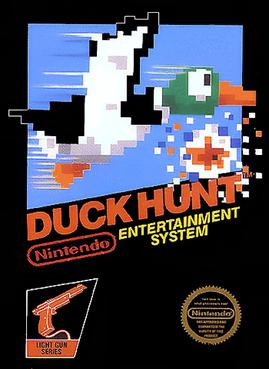
Duck Hunt is a 1984 light gun shooter video game developed and published by Nintendo for the Nintendo Entertainment System (NES). The game was first released in April 1984 in Japan for the Family Computer (Famicom) console and in North America as an arcade game for the Nintendo VS. System. It became a launch game for the NES in North America in October 1985, and was re-released in Europe two years later.
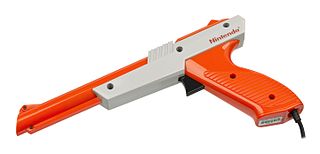
A light gun is a pointing device for computers and a control device for arcade and video games, typically shaped to resemble a pistol.

The Zapper is an electronic light gun accessory launched within the Nintendo Entertainment System (NES) in North America on October 18, 1985. It is a cosmetic redesign by Nintendo of America's head designer Lance Barr, based on Gunpei Yokoi's Video Shooting Series light gun (光線銃シリーズガン), which had been released in Japan for the Famicom on February 18, 1984. The Zapper requires compatible NES games, such as Duck Hunt, Wild Gunman, and Hogan's Alley. Its internal optical sensor allows the player to aim at a television set and accurately shoot at in-game targets.

R.O.B. is a toy robot accessory for the Nintendo Entertainment System (NES). It was key to the NES's launch in October 1985, as a redesign of the Family Computer Robot which had been launched in July 1985 in Japan for Famicom. Its short lifespan yielded only two games in the Robot Series: Gyromite and Stack-Up.

The Adventures of Bayou Billy is an action game released by Konami for the Nintendo Entertainment System in North America in 1989 and in the PAL region in 1991. It is a revised version of the 1988 Family Computer game Mad City (マッド・シティ), which has been modified with many graphical changes and an increase in the game's difficulty level. The game employs three play styles that were popular at the time: beat 'em up, light gun shooting and racing.

Hogan's Alley is a light gun shooter video game developed and published by Nintendo. It was released for the Family Computer in 1984 and then the arcade Nintendo VS. System and Nintendo Entertainment System in 1985. It was one of the first hit video games to use a light gun as an input device, along with Nintendo's Duck Hunt (1984). The game presents players with "cardboard cut-outs" of gangsters and innocent civilians. The player must shoot the gangs and spare the innocent people. It was a major arcade hit in the United States and Europe.

Gumshoe is a light gun shooter video game developed and published by Nintendo for the VS. System arcade hardware and the Nintendo Entertainment System console. It was released in 1986 in North America and in 1988 in Europe. Unusual for a Nintendo game, it was not released in Japan. It was designed by Yoshio Sakamoto.

To the Earth is a light gun shooter video game developed by Cirque Verte and published by Nintendo for the Nintendo Entertainment System. It was released in November 1989 in North America and in Europe on February 23, 1990. It uses the NES Zapper to destroy ships and gain power-ups. The enemy spacecraft require good reflexes and aiming.
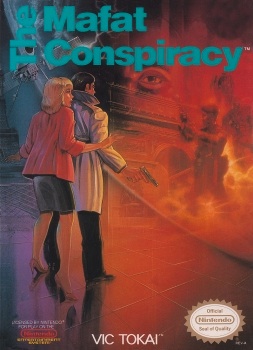
The Mafat Conspiracy is a Nintendo Entertainment System video game released in 1990. It is the sequel to Golgo 13: Top Secret Episode.

Lemmings Paintball is an action video game from the Lemmings franchise made by Visual Science and published by Psygnosis in 1996.

Laser Invasion, released as Gun Sight (ガンサイト) in Japan, is a multi-genre first-person action game released by Konami for the Nintendo Entertainment System in 1991. The player takes control of a military operative who pilots an attack helicopter in order to infiltrate various enemy bases and fulfill his mission. The game supports the standard NES controller, as well as the NES Zapper light gun and the LaserScope, a voice-activated headset controller Konami released for the NES that was compatible with all light gun games released for the system. The American version of the game featured a rebate for the LaserScope in the instruction booklet.

Extreme PaintBrawl is a paintball video game released for DOS/Windows on October 20, 1998. The game is considered to be one of the worst video games ever made. Extreme PaintBrawl was developed in two weeks using the Build engine; its soundtrack was composed by musician Todd Duane, who sent his demo tracks to Head Games. The game was followed by Extreme PaintBrawl 2 in 1999, Ultimate PaintBrawl 3 in 2000, and Extreme PaintBrawl 4 in 2002, all of which were met with negative reviews.
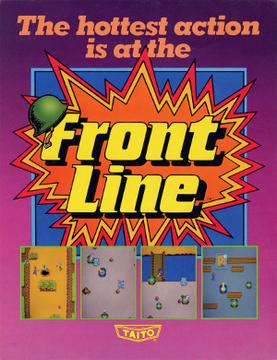
Front Line is a military-themed run and gun video game released by Taito for arcades in November 1982. It was one of the first overhead run and gun games, a precursor to many similarly-themed games of the mid-to-late 1980s. Front Line is controlled with a joystick, a single button, and a rotary dial that can be pushed in like a button. The single button is used to throw grenades and to enter and exit tanks, while the rotary dial aims and fires the player's gun.

Track & Field II, known in Japan as Konami Sports in Seoul, is a sequel to Track & Field created by Konami for the NES in 1988. It still continues the Olympic-themed sports events, but adds more realism by choosing a country for the player to represent. The series boasted 15 sporting events, with two of them available as bonus stages between rounds of the "Olympic" mode.

Rambo III is a series of video games based on the film Rambo III (1988). Like in the film, their main plots center on former Vietnam-era Green Beret John Rambo being recalled up to duty one last time to rescue his former commander, Colonel Sam Trautman, who was captured during a covert operation mission in Soviet-controlled Afghanistan. Taito released an arcade video game based on the film. The console versions were developed and published by Sega, the IBM PC compatible version was developed by Ocean and published by Taito, and Ocean developed and published the other home computer versions: Atari ST, Amiga, Spectrum, C64, Amstrad CPC.

The Wii Zapper is a gun shell peripheral for the Wii Remote. The name is a reference to and successor of the NES Zapper light gun for the Nintendo Entertainment System. It is mainly used to enhance controls for shooter games, including light gun shooters, first-person shooters, and third-person shooters.

Link's Crossbow Training is a shooting video game developed and published by Nintendo for the Wii video game console. It was bundled with the Wii Zapper peripheral and was the first title to use it. The game was released worldwide in 2007, and in Japan in May 2008. It uses several environments, enemies, and other assets from The Legend of Zelda: Twilight Princess as stages for targets with various shootable background objects.

Freedom Force is a video game developed and published by Sunsoft for the Nintendo Entertainment System in 1988. The player takes the role of a sharpshooter in a counter-terrorist organization. This is one of the few games to require the NES Zapper light gun accessory. The game was released in arcades by Nintendo on the Nintendo VS. System as VS. Freedom Force that year.
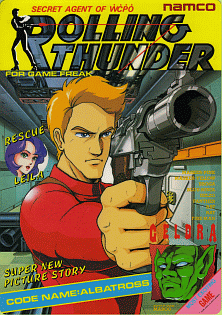
Rolling Thunder is a run and gun video game developed by Namco in Japan and Europe and released in 1986 as a coin-operated arcade video game using the Namco System 86 hardware. It was distributed in North America by Atari Games. The player takes control of a secret agent who must rescue his female partner from a terrorist organization. Rolling Thunder was a commercial success in arcades, and it was released for various home computer platforms in 1987 and the Nintendo Entertainment System in 1989. The original arcade game has been included in various classic game compilations as well. It influenced later arcade action franchises such as Shinobi and Time Crisis, which borrowed mechanics such as taking cover behind crates. On March 17, 2022, the arcade version of the game got ported as part of the Arcade Archives series.
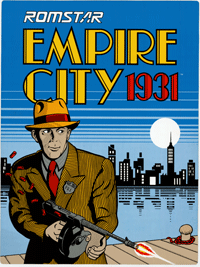
Empire City: 1931 is a shooter game developed by Seibu Kaihatsu that was originally released into arcades in 1986, by Taito in Japan and Europe and by Romstar in North America. The game has players taking on the mafia in 1931 New York City by gunning down mobsters one by one.





















